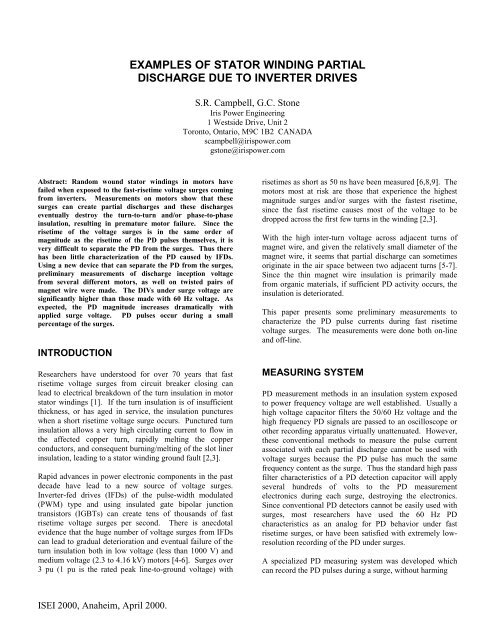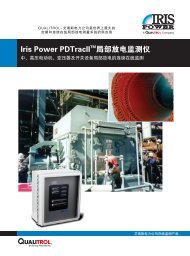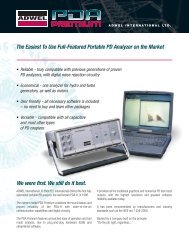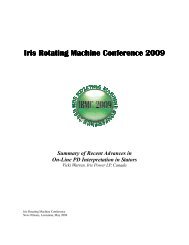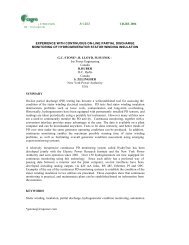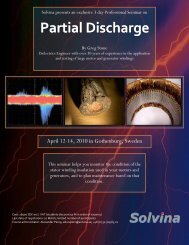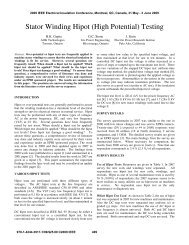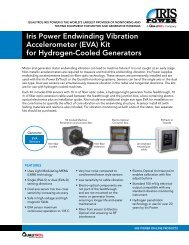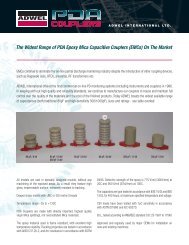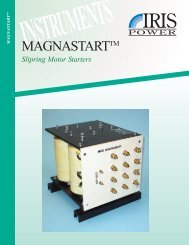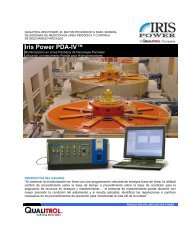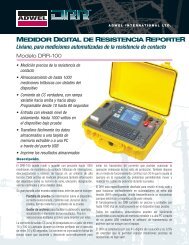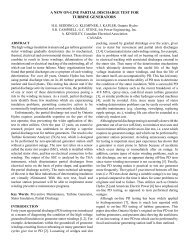EXAMPLES OF STATOR WINDING PARTIAL - Iris Power Engineering
EXAMPLES OF STATOR WINDING PARTIAL - Iris Power Engineering
EXAMPLES OF STATOR WINDING PARTIAL - Iris Power Engineering
You also want an ePaper? Increase the reach of your titles
YUMPU automatically turns print PDFs into web optimized ePapers that Google loves.
<strong>EXAMPLES</strong> <strong>OF</strong> <strong>STATOR</strong> <strong>WINDING</strong> <strong>PARTIAL</strong>DISCHARGE DUE TO INVERTER DRIVESS.R. Campbell, G.C. Stone<strong>Iris</strong> <strong>Power</strong> <strong>Engineering</strong>1 Westside Drive, Unit 2Toronto, Ontario, M9C 1B2 CANADAscampbell@irispower.comgstone@irispower.comAbstract: Random wound stator windings in motors havefailed when exposed to the fast-risetime voltage surges comingfrom inverters. Measurements on motors show that thesesurges can create partial discharges and these dischargeseventually destroy the turn-to-turn and/or phase-to-phaseinsulation, resulting in premature motor failure. Since therisetime of the voltage surges is in the same order ofmagnitude as the risetime of the PD pulses themselves, it isvery difficult to separate the PD from the surges. Thus therehas been little characterization of the PD caused by IFDs.Using a new device that can separate the PD from the surges,preliminary measurements of discharge inception voltagefrom several different motors, as well on twisted pairs ofmagnet wire were made. The DIVs under surge voltage aresignificantly higher than those made with 60 Hz voltage. Asexpected, the PD magnitude increases dramatically withapplied surge voltage. PD pulses occur during a smallpercentage of the surges.INTRODUCTIONResearchers have understood for over 70 years that fastrisetime voltage surges from circuit breaker closing canlead to electrical breakdown of the turn insulation in motorstator windings [1]. If the turn insulation is of insufficientthickness, or has aged in service, the insulation punctureswhen a short risetime voltage surge occurs. Punctured turninsulation allows a very high circulating current to flow inthe affected copper turn, rapidly melting the copperconductors, and consequent burning/melting of the slot linerinsulation, leading to a stator winding ground fault [2,3].Rapid advances in power electronic components in the pastdecade have lead to a new source of voltage surges.Inverter-fed drives (IFDs) of the pulse-width modulated(PWM) type and using insulated gate bipolar junctiontransistors (IGBTs) can create tens of thousands of fastrisetime voltage surges per second. There is anecdotalevidence that the huge number of voltage surges from IFDscan lead to gradual deterioration and eventual failure of theturn insulation both in low voltage (less than 1000 V) andmedium voltage (2.3 to 4.16 kV) motors [4-6]. Surges over3 pu (1 pu is the rated peak line-to-ground voltage) withrisetimes as short as 50 ns have been measured [6,8,9]. Themotors most at risk are those that experience the highestmagnitude surges and/or surges with the fastest risetime,since the fast risetime causes most of the voltage to bedropped across the first few turns in the winding [2,3].With the high inter-turn voltage across adjacent turns ofmagnet wire, and given the relatively small diameter of themagnet wire, it seems that partial discharge can sometimesoriginate in the air space between two adjacent turns [5-7].Since the thin magnet wire insulation is primarily madefrom organic materials, if sufficient PD activity occurs, theinsulation is deteriorated.This paper presents some preliminary measurements tocharacterize the PD pulse currents during fast risetimevoltage surges. The measurements were done both on-lineand off-line.MEASURING SYSTEMPD measurement methods in an insulation system exposedto power frequency voltage are well established. Usually ahigh voltage capacitor filters the 50/60 Hz voltage and thehigh frequency PD signals are passed to an oscilloscope orother recording apparatus virtually unattenuated. However,these conventional methods to measure the pulse currentassociated with each partial discharge cannot be used withvoltage surges because the PD pulse has much the samefrequency content as the surge. Thus the standard high passfilter characteristics of a PD detection capacitor will applyseveral hundreds of volts to the PD measurementelectronics during each surge, destroying the electronics.Since conventional PD detectors cannot be easily used withsurges, most researchers have used the 60 Hz PDcharacteristics as an analog for PD behavior under fastrisetime surges, or have been satisfied with extremely lowresolutionrecording of the PD under surges.A specialized PD measuring system was developed whichcan record the PD pulses during a surge, without harmingISEI 2000, Anaheim, April 2000.
the electronics. The new device, called XTrac, can be usedeither off-line (voltage source from a fast risetime surgetester) or on-line where a PWM IFD creates the surges.Further details on the new device are in reference [8]. AnHP54542 digital oscilloscope was used to record the PDsignals from the new detector.PD PULSE CHARACTERISTICSThe new PD measurement system was used to collectpreliminary data on the nature of PD caused by fast risetimesurges on both random wound motors and on twisted pairsof magnet wire.detector indicates that the PD is oscillatory (an artifact ofthe measurement system), and has a risetime of about 5 ns.As with the IFD, there is still some of the residual surgethat comes through the device, but it has a lower frequencycontent, i.e. it is easily distinguishable from the PD pulse.The surge voltage has been reduced by over 66 db. At thePD inception voltage, PD rarely occurs on every surge(Figure 3). As is to be expected, as the surge voltage isfurther increased above the DIV, a higher and higherpercentage of the surges experience PD. Also, some of thePD starts occurring at lower voltages on the wavefront. Insome cases, the PD was seen to occur on subsequent ringsof the surge.Figure 1 shows the oscilloscope waveform of a PD pulse inan operating motor driven by an IFD. The PD pulse wasextracted from a surge, using the specialized PD measuringsystem. Clearly, PD can occur in motors driven by IFDs. Itseems that most surges do not produce PD. However, ifsufficient numbers of surges are applied, PD willoccasionally result. The PD is the fast transient, with theinitial peak lasting less than 10 ns. The wave response justbefore the PD in Trace 1 is relatively slow, and is whatremains of the voltage surge. The surge is attenuated over60 db.A single PD pulse recorded in an off-line test using amodern Baker Model D1200 surge tester is shown in Figure2. The surge tester, which uses an IGBT as a switchingdevice, has a surge risetime of 100 ns, at the motorterminals. The high frequency output from the newFigure 2 - PD (lower trace) recorded during a single surge (uppertrace) from a surge tester.Figure 3 - ‘Infinite persistence’ recording of multiple PD pulses(trace 1) occurring at the peak of the surge voltage on the samemotor as in Figure 4. Since the PD pulses appear as a light tracecompared to the bold surge (and the surge transient recorded onthe PD signal output) it is clear that most surges do not produce aPD pulse.Figure 1 – PD pulse collected at the motor using a 600V IFDoperating at 60 Hz. Channel 1 is PD from Phase A. Channel 2 isa A Phase Transient (divided by 2000). Channel 3 is B PhaseTransient (divided by 2000). Channel 4 is C Phase Transient(divided by 2000).
INCEPTION AND EXTINCTION VOLTAGESThe PD inception voltages were measured on twisted pairmagnet wires, as well as three commercial motors. Table 1shows the DIV on 4 different twisted pair magnet wiresamples when subjected both to 60 Hz and 100 ns risetimevoltage surges. The magnet wire was all of the samediameter (18 AWG), with two samples conventional quadbuild, and 2 samples quad build with a corona resistantfiller. The surge voltage is the peak-recorded voltage. The60 Hz voltage is the rms voltage. It is evident that the rms(or even the zero to peak) DIV for 60 Hz is substantiallylower than the DIV under a voltage surge. This is notsurprising. Note that the DIVs in Table 1 were measuredwith the new PD device, which produces a PD signal that isabout 12 times higher than a conventional capacitivedetector. After the PD measurements, it was confirmed thatthe pairs of magnet wires were not shorted.Three commercial motors were also measured for the DIVand DEV under surge voltage. The DIV/DEV under 60 Hzwas not measured, since this would have involved phase-toground,rather than turn-to-turn insulation. The motorsranged from 1 HP to 20 HP. All were rated 440V, 3 phase.Table 2 shows that the lowest DEV was 1.6 kV. For thismotor, PD would only occur if the applied surge voltage isgreater than 4.4 pu, which is unlikely [9]. Thus, none ofthese motors are likely to fail in-service due to PD. The PDmagnitude at inception is also listed in Table 2.PD VERSUS SURGE VOLTAGEMeasurements were made on a 1 HP motor to determinehow the PD magnitude is affected by surge voltage. Themeasurements were made at atmospheric pressure and22°C. As shown in Figure 4, around the inception voltage,the PD magnitude increased dramatically. Similar to whatoccurs under 60 Hz voltage, eventually the PD magnitudesaturates. Since the PD magnitude increases over 10 timesin a narrow voltage range just above inception, this makesPD inception measurements relatively easy, and precise.Table 1 - DIV for twisted pair magnet wire samplesTable 2 - Inception and extinction voltages of MotorsRating Phase DIV(kV)DEV(kV)1 HP T1 1.9 1.7 600T2 2.3 2.1 300T3 2.3 2.2 40010 HP T1 2.4 2.2 600T2 2.2 1.8 50T3 2.3 2.1 15020 HP T1 2.4 2.3 50T2 2.4 2.1 400T3 1.8 1.6 30060005000400030002000100000 1000 2000 3000 4000PDMagnitude(mV)Figure 4 - PD magnitude as a function of applied surge voltage(100 ns risetime). The vertical scale is the PD magnitude from thenew detector, in mV. The surge voltage (V) is the horizontalscale.CONCLUSIONST1T2T3VoltageTypeSurge(peak V)60 Hz (Vrms)1A 2A 1CR 2CR2000 2200 2400 2200660 640 740 7001. Premature failure of stator windings in low voltagemotors have been observed due to partialdischarges created between turns. The root causeof the PD is the high interturn voltage that canoccur due to the fast risetime, high magnitudesurges produced by some types of IFDs.2. Measurement of the PD during surges is difficultwith conventional PD detectors, since thefrequency content of the surge is close to thefrequency content of the PD pulse currents.
3. A new PD detection device that can extract the PDpulses from fast risetime surges has beendeveloped.4. The PD inception voltage from severalconventional motors has been measured. The DIVof these particular motors is higher than thenormally expected peak surges from IFDs. TheDIV can be readily determined since the PDmagnitude is a strong function of applied voltage.5. The DIV under surge voltage (100 ns risetime) issubstantially higher than the PD occurring during60 Hz AC.6. Further work is needed to determine the effect ofhumidity, temperature and insulation aging on PDmagnitude. However, with this new tool, userscan objectively measure PD characteristics underrealistic voltage conditions [10].ACKNOWLEDGMENTSThe authors would like to thank Mr. Dave Schump of BakerInstruments for providing a fast risetime surge generator.We are also indebted for advice from Dr. G. Gao of TecoWestinghouse Motors.REFERENCES[1] E.W. Boehne, “Voltage Oscillations in ArmatureWindings Under Lightning Impulses,” Trans AIEE,1930, p1587.[2] M.T. Wright, S.J. Yang, and K. McCleay, “GeneralTheory of Fast-Fronted Interturn Voltage Distributionin Electrical Machine Windings,” Proc. IEE, Part B,July 1983, p245.[3] B.K. Gupta, et al, “Turn Insulation Capability of LargeAC Motors,” Parts 1, 2, 3, IEEE Trans EC, December1987, p658.[4] A.L. Lynn, W.A. Gottung, D.R. Johnston, “CoronaResistant Turn Insulation in AC Rotating Machines,”Proc. IEEE Electrical Insulation Conference, Chicago,October 1985, p308.[5] W. Yin, et al, “Improved Magnet Wire for Inverter-FedMotors,” Proc. IEEE Electrical Insulation Conference,Chicago, September 1997, p379.[6] E. Persson, ‘Transient Effects in Applications of PWMInverters to Induction Motors’, IEEE Trans IAS, Sept1992, p1095.[7] G.C. Stone, R.G. vanHeeswijk, R. Bartnikas,“Electrical Aging and Electroluminesence in EpoxyUnder Repetitive Surges”, IEEE Trans EI, April 1992.[8] G.C. Stone, S.R. Campbell, M. Susnik, “ New Tools toDetermine the Vulnerability of Stator Windings toVoltage Surges from IFDs”, Proc. IEEE ElectricalInsulation Conference, Cincinnati, October 1999, p149.[9] S. Campbell, B.A. Lloyd, G.C. Stone, S. Tetreault,“Which Inverter Drives Need Upgraded Motor StatorWindings”, IEEE Petroleum and Chemical IndustryConference, Sept 2000.[10] G.G. Gao, M. Steinhauser, R. Kavanaugh, “Studies onthe Insulation Life of ASD Fed Motors UnderAccelerated Aging Conditions”, Proc IEEE Conferenceon Electrical Insulation and Dielectric Phenomena,Austin TX, October 1999, pp 581-584.


